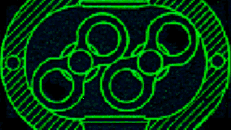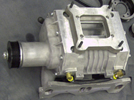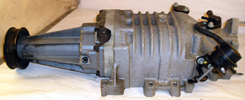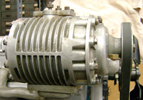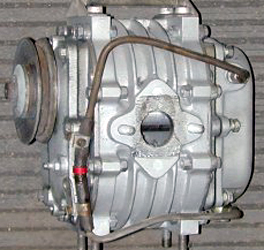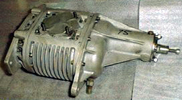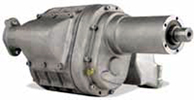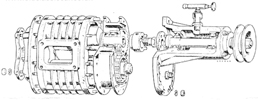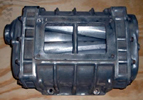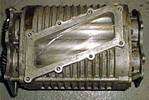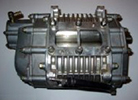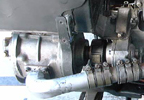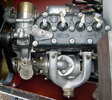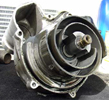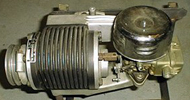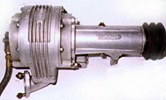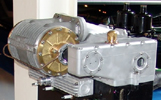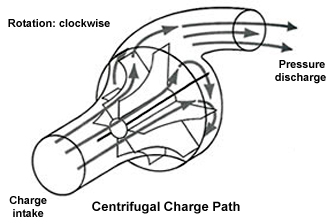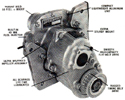 Supercharger Installation, Part 3 |
||||
 |
FastCounter by bCentral |
Positive Displacement Type, Twin Screw | ||||||||
Link |
Mfg. | Rotation |
Size, L |
Ratio |
Max RPM |
Oil |
Comment | |
Opcon Autorotor (SRM AB) | CW |
.32-* |
2:1-4:1 |
Oil bath |
||||
Centrifugal Type | ||||||||
Link |
Mfg. | Rotation |
Size, L |
Ratio |
Max RPM |
Oil |
Comment | |
Drouin | 2:1-4:1 |
|||||||
Rotrex | CW |
2:1-3:1 |
200,000 |
Internal pump, external tank |
||||
Positive Displacement Types |
This group, including twin rotor, twin screw, and eccentric vane types, mechanically captures a small volume of intake charge between two components and forces it into another state. Absent leakage, the transfer and compression are very efficient except for an increase in temperature proportionate to the boost. Some types are true superchargers where there is internal charge compression, and some are better described as blowers where the compression only takes place in the manifold. Higher boost rates increase the discharge temperature, which produces less effective power for the amount of boost.
|
Camden | ||||
This was a high quality unit made by . AFor more Camden information: |
| |||
Chinn | ||||
Derek Chinn currently manufactures superchargers with capacity between 900cc to 3500cc per revolution. For more Chinn information: |
| |||
Eaton | ||||
Eaton is the most common current original equipment supercharger, used by Ford, Mercedes, Jaguar, General Motors, VW, &c. They do not sell to the public, but the units are available from Magnuson and various other sources. The rotors twisted 60° along their length, which is an improvement over the straight rotored roots type. |
| |||
The charge flows from the intake port at the end of the rotors (axially), splits into two streams each of which is captured between a rotor lobe and the housing’s inner surface, and forced into the discharge port, as shown. This may be the top, bottom, or side depending on the orientation of the housing but the discharge is at 90° to the intake port. No charge passes between the rotors.
| ||||
Eaton Superchargers | |||||
Model Number | M24 | M45 | M62 | M90 | M112 |
Displacement per revolution, Liters | .393 | .737 | 1.016 | 1.475 | 1.835 |
Displacement per revolution, Cubic Inches | 24 | 45 | 62 | 90 | 112 |
Sustained RPM | 15,000 | 16,000 | 12,000 | 11,000 | 10,000 |
Maximum RPM | 15,000 | 16,000 | 12,000 | 11,000 | 10,000 |
Italmechanica | ||||
Also known as SCOT, S.C.O.T., S.Co.T., Supercharger Company of Turin, and I. T. Supercharger. |
| |||
M.A.G. | ||||
This was a high quality unit by Motosacoche S.A. in Switzerland. Also known as MAG. For more M.A.G. information: |
| |||
Magnuson | ||||
Also known as “Magnacharger. For more Magnuson information: |
| |||
Marshall | ||||
The Marshall “cabin blower” was originally installed on light aircraft to compensate cabin air for high altitude. The most commonly used model (C75B) has a displacement of about 36” (600cc) per revolution. For more Marshall information: |
| |||
Moss | ||||
This is a modern replica of the Marshall for smaller sports car engines. Moss also currently supplies what appears to be an Eaton for larger engines. For more Moss information: |
| |||
Nordec (a.k.a. Marshall-Nordec, Godfrey-Nordec) | ||||
This was an automotive installation using the Marshall cabin blower as the core component, and was made by North Downs Engineering Company Ltd. For more Nordec information: |
| |||
Pepco | ||||
Progressive Engine Products Company, Inc. made superchargers for VW from around 1950. Fageol sold them. Crofton took over from them about 1959. There were two case sizes, 4” and 6” lengths with remaining dimensions in common. For more Pepco information: | ||||
Roots | ||||
This manufacturer provided blowers for industrial air supply and purging diesel engines, some of which have been adapted and modified for automotive use. The name has become generic, including the common automotive and industrial BDS, B&M Automotive, Dyer, GMC, Hampton, Holley, Littlefield, Weiand, &c. almost all of which are too large and heavy for consideration for any but the |
| |||
largest displacement engines. Even the smallest of these (3-53) is very bulky and inefficient compared to more modern designs such as the Eaton. For more Roots information: | ||||
Wade | ||||
This was available in twoi sizes. The RO20 is 2000cc displacement per revolution for engines from 2000 to 3000cc for between 5-8.0 psi boost. Two drive ratios were used 0.8:1 and 1:1 depending on the power required. An RO20 supercharger fitted to a 1300cc engine with a drive ratio of 1:1.0 will supply a maximum boost of up to 18 psi. The RO20 weighs 40 lbs. The maximum rotor speed is |
| |||
6,500 rpm; for continuous use 6,000 rpm. The RO34 is a longer RO20, with displacement per revolution of 3400cc for engines from 3000 to 5000cc at 6,000 and 5,500 rpm. For more Wade information: | ||||
Volumex | ||||
For more Volumex information: |
| |||
Positive Displacement, Twin Screw | ||
These superchargers (like the twin rotor types) have two rotors turning in opposite directions. The rotors are multi-lobed helix, and are generally driven by counter-rotating gears inside the front housing. Each rotor is radially symmetrical, but laterally asymmetrical.
| ||
Opcon Autorotor | ||||
This is the oldest true compressor, also known as an “axial flow” compressor, which was developed by Svenska Rotor Maskiner (SRM) in 1936. Alf Lysholm was the design engineer. It reduces the volume of the intake charge internally. Manufactured under license by IHI for Mazda, and for Sprintex, PSI, Whipple, &c. For more Opcon Autorotor supercharger information: |
| |||
Positive Displacement, Eccentric Vane | ||
A rotating central drum or cylinder with vanes on its circumference draws in the charge. The drum is located eccentrically in the housing and rotates off-center, with the largest clearance between a vane and housing at the inlet port. The clearance decreases in size as the drum rotates, compressing the charge to a smaller volume and higher pressure until the vane reaches the discharge port, where the charge exits. These are true superchargers, where the charge is compressed before being discharged into the intake manifold.
| ||
Arnott | ||||
This was manufactured for sports car engines such as the M.G. TD, &c. by Carburettors Ltd. It had its own external oil supply, pressurized by boost. Two sizes were supplied, Model 1600 (525cc) and Model 166 (825cc) per revolution. For more Arnott information: |
| |||
Centric | ||||
The Centric supercharger is the main limiting factor as it was originally designed to run at about 4500rpm and being driven at engine speed is doubling its designed performance. Designed by Shorrock before WW2. The vanes ride on trunnions to prevent them from contacting the housing surface, which permits a certain degree of air leakage but reduces wear and operating temperatures. For more Centric information: |
| |||
Cozette | ||||
This is a pre-WW2 item used on smaller British and European sports cars, now obsolete. Some had vertical drives. The vanes ride on trunnions to prevent them from contacting the housing surface, which permits a certain degree of air leakage but reduces wear and operating temperatures. For more Cozette information: |
| |||
G-Lader | ||||
This type is only used by VW GmbH. it is similar in appearance to both the eccentric vane and centrifugal types. The single rotor and the housing have spiral walls that intermesh to provide a maze-like air passage.
The rotor oscillates on an eccentric shaft and the constantly changing internal volume between the spiral walls provides a pumping effect. Air enters at the periphery of the spiral walls and is exhausted near the central axis. There are two models, G40 and G60; I’m going to guess that rather than being arbitrary numbers they are based on the capacity in liters: 400cc and 600cc. For more G-Lader information: |
| |||
Judson | ||||
Judson superchargers were sold for installation on VW, Corvair, MG, Triumph sports cars, etc. Judson (and Wray) vanes seal by contact to the housing inner surface, and consequently have higher efficiency but also higher operating temperatures, both for the unit itself and also the discharge. For more Judson information: |
| |||
Shorrock | ||||
This is one of the oldest and most common. It was available in several sizes, and three port orientations. the inlet and outlet ports are side by side and the charge flows through the casing in a horseshoe path. One of the ports can be seen at the top with four mounting studs. There was a straight through i.e. 180° model and, rarest of all a, 90° version. The vanes ride on trunnions to |
| |||
prevent them from contacting the housing surface, which permits a certain degree of air leakage but reduces wear and operating temperatures. For more Shorrock information: | ||||
Shorrock Superchargers | |||
Model number | C75 | C142 | C250 |
Displacement per revolution, cubic centimeters | 750 | 1420 | 2500 |
Displacement per revolution, cubic inches | 46 | 87 | 153 |
Maximum RPM | 7,000 | 6,000 | 5,000 |
Zoller | ||||
This is a pre-WW2 item used on British and European sports cars, as well as the 1939 AJS V4, now obsolete. It was chain-driven in some applications. For more Zoller information: |
| |||
Centrifugal | ||||
This type has a different flow path than positive displacement types. Charge air enters at the center of the compressor’s axis of rotation, flows radially into the vanes, and is discharged tangentially. In general, centrifugal superchargers produce boost in direct proportion to their displacement per revolution, and the square of their rotational speed (except for leakage). E.g., a centrifugal supercharger turning at 10,000 RPM will produce four times as much boost |
| |||
pressure as the same unit turning at 5,000 RPM. Higher boost rates increase the discharge temperature, which produces less effective power for the amount of boost.
| ||||
Drouin | ||||
This is a motorcycle unit offered for Norton, Harley-Davidson and others complete with a primary drive. For more Drouin information: |
| |||
Rotrex | ||||
Manufactured in Denmark. The C15-16 is suitable to engines from 30-130 hp. It has an internal planetary drive at 1:12.67, so the drive from the engine need not be a high ratio, although up to 200,000 RPM is safe. For more Rotrex information: |
| |||
Supercharger Topics | |||||||
|
Choices |
|
Engine Design |
|
|
Links | |
 |
I'm trying to locate some people I used to know; please click here for more details. Thanks! | |||||
British |
British |
Victory Library |
Harley-Davidson |
Mopar | |
